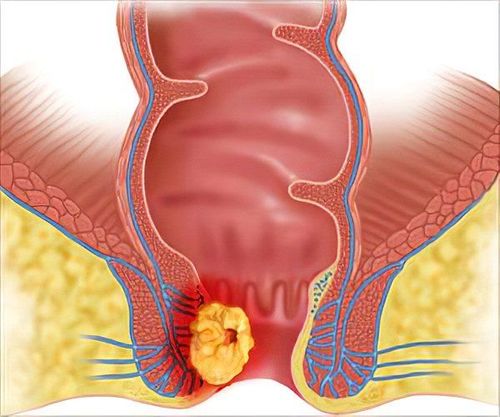This is an automatically translated article.
Fluorouracil also known as FU or 5FU, works in combination with other cancer drugs to treat conditions including breast cancer, head and neck cancer, anal cancer, stomach cancer or colon cancer.
1. What is the effect of Fluorouracil?
Fluorouracil is a type of chemotherapy drug called a cell cycle-specific antimetabolite. When cells incorporate these substances into the cell's metabolism, they become unable to divide. Accordingly, the mechanism of action of anti-metabolites is to attack cells at specific stages in the cycle, inhibiting replication and proliferation. In addition, anti-metabolites are classified according to the specific receptor they interfere with; where Fluorouracil is classified as a pyrimidine analog because of its interference in DNA and RNA synthesis.
In medical practice, Fluorouracil is used as an anti-cancer drug. The indications for use of Fluorouracil are many common cancers, especially colon cancer, esophageal cancer, stomach cancer, pancreatic cancer, head and neck cancer and breast cancer. At the same time, the drug Fluorouracil can also be used in combination with other anti-cancer agents such as chemotherapy or radiation therapy to increase the ability to control malignant cells.
2. How to use Fluorouracil?
Fluorouracil is used in the form of an infusion and the dose will depend on the patient's health condition and body weight. In addition, the doctor will also adjust the dose of the drug if the patient has liver damage, kidney dysfunction as well as abnormalities on the blood count test results.
When used, Fluorouracil drug needs to be diluted with glucose solution, sodium chloride solution or water before injection. The route of entry is intravenous as a conventional injection or by slow injection through a drip as an infusion.
You should always have blood tests during and after Fluorouracil treatment to check the level of cells in your blood. Discontinuation of treatment will sometimes be necessary if the leukocyte and platelet levels fall too low.

Thuốc Fluorouracil cần được sử dụng theo đúng chỉ dẫn
3. Things to keep in mind when using Fluorouracil
Do not use Fluorouracil if you have one of the following conditions:
Are allergic (hypersensitive) to Fluorouracil or any other ingredient Having a serious infection (eg Herpes) zoster, chickenpox) If the tumor is not malignant Has been greatly weakened by prolonged illness or other comorbidities If the bone marrow has been damaged by other treatments (including including radiation therapy) While being treated with brivudine, sorivudine and similar antiviral drugs Severe acute liver failure Pregnant or breastfeeding During treatment with Fluorouracil, the patient regularly monitored for the following: Complete blood count. If the blood cell count becomes too low, the person needs to delay taking the medicine Have mouth sores, fever or bleeding anywhere - these symptoms may be a result of the cell count very low in the blood Changes in kidney function Signs of liver damage suspected, including yellowing of the skin, eyes, or indigestion Symptoms of heart problems such as angina Other medications to consider Mention to patients being treated with Fluorouracil
Methotrexate (an anti-cancer drug) Metronidazole (an antibiotic) Calcium leucovorin (also known as calcium folinate - used to reduce the harmful effects of anti-cancer drugs) Allopurinol (used to lower blood uric acid) Cimetidine (used to inhibit acid secretion in the stomach) Warfarin (used to treat blood clots) Interferon alpha 2a; brivudin, sorivudine and analogues (antiviral drugs) Cisplatin (anticancer drug) Phen ytoin (used to control seizures/edema and irregular heartbeat) Vinorelbine vaccine (an anti-inflammatory drug) cancer) Cyclophosphamide (an anti-cancer drug) Levamisol (medicine used to treat worm infections) Tamoxifen (an anti-cancer drug)

Fluorouracil cần cân nhắc khi người bệnh đang dùng một số thuốc điều trị bệnh khác
4. Possible side effects with Fluorouracil
Fluorouracil side effects are usually predictable in terms of their onset and severity. Fortunately, the side effects of Fluorouracil can be quite manageable and there are many options to minimize or prevent them. However, adverse reactions improve once chemotherapy has been completed.
The following side effects are common (occurrence in more than 30%) in patients taking Fluorouracil :
Diarrhea Nausea and occasionally vomiting Mouth sores Poor appetite Changes in vision Changes in taste , a metallic taste in the mouth during infusion Discoloration along the vein in which the medicine is given Blood cells are temporarily reduced but this can increase the risk of infection, anemia and/or bleeding. In addition, the less common side effects (occurring in about 10-29%) of patients taking Fluorouracil are skin reactions that cause dryness, cracking, peeling, or darkening of the skin where the radiation was treated. earlier due to radiation recovery); thin hair; nail change. Also, although rare, Fluorouracil can cause serious adverse cardiovascular events such as chest pain, ECG changes and elevation of cardiac enzymes, especially in patients with a history of heart disease. .
In summary, the drug Fluorouracil is an antineoplastic chemotherapy drug classified as an anti-metabolite. Drugs are often combined with many other multimodal measures in the control of malignant cells. At the same time, during treatment, patients should be closely monitored, early detection of unwanted effects to promptly adjust, ensure the safety of other organ systems in the process of destroying cancer. at the target organ.
Please dial HOTLINE for more information or register for an appointment HERE. Download MyVinmec app to make appointments faster and to manage your bookings easily.
References: webmd.com, chemocare.com, cancerresearchuk.org, medicines.org.uk












